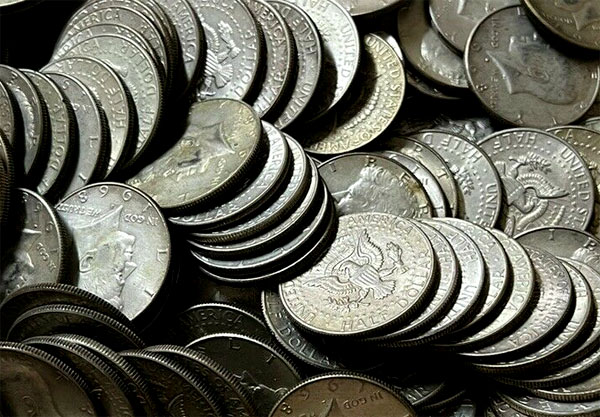Kennedy Half Dollar Silver Coins
The Kennedy half dollar coin is a coin that was minted in 1964 by the United States Government. It was issued during the presidency of John F. Kennedy and is permanently ensconced in American currency as the smallest denomination coin in circulation, with a total face value of fifty cents. Half Dollar Coin specs can be found on the US Mint website.
 The Kennedy half dollar coin was issued by United States Mint to celebrate the life and legacy of President John F. Kennedy and is one of the mint’s most popular issues. Even though the coin was immediately popular when it was first issued, for many years, it had less than its average mintage due to a period in which there were no new 50-cent pieces on the issue from 1977 until 1981, when the United States Mint issued a new design featuring Lady Liberty instead of President Kennedy. The Kennedy half dollar coin is considered not just to be a commemorative coin in America but also a currency itself.
The Kennedy half dollar coin was issued by United States Mint to celebrate the life and legacy of President John F. Kennedy and is one of the mint’s most popular issues. Even though the coin was immediately popular when it was first issued, for many years, it had less than its average mintage due to a period in which there were no new 50-cent pieces on the issue from 1977 until 1981, when the United States Mint issued a new design featuring Lady Liberty instead of President Kennedy. The Kennedy half dollar coin is considered not just to be a commemorative coin in America but also a currency itself.
The Kennedy Half Dollar Design
The 1964 Kennedy half dollar was the first commemorative coin ever minted in the United States. It was also issued in 1965, 1967 and 1970, only a few years after its 1964 debut. By 1971, when a new Kennedy half dollar coin was put into circulation, and those already in circulation had been circulating for years, six million 1964 Kennedy halves were circulating the country. At that time, mintages of the coins were 25 million.
On the obverse of the coin is a depiction of John F. Kennedy, while on the reverse is a design of Lady Liberty. The reverse was originally intended to be a traditional profile view of President Kennedy, but he died before this design was executed in his honor. The executed design instead features a depiction of an American bald eagle looking to the right with one wing spread in flight with an olive branch and banner held out in both hands.
Mintage: The mintage of the 1964 Kennedy half dollar coin was at a low point for many years after its initial launch. The main reasoning for this was that it was not until 1976 that a new Kennedy half dollar was minted after the second one was issued, suggesting the series ended between 1975 and 1976. This was because many 1964 Kennedy half dollars were in circulation when they were no longer needed or wanted. With the years going by, many continued to be circulated because of their dated design as a piece of history, their low value, and their passing on at a rate of fewer than ten cents per face value.
Legislation: The Kennedy half dollar has been issued for circulation every year since 1964. In 1970, legislation was passed by the United States Congress that required all of the Kennedy half dollars that had been minted up to that point to be melted down and recast. The only exception made was for those coins that had already been issued and were in circulation.
In 1971, an act passed by the United States Congress stopped the production of new silver coins being minted. This act put an end to all silver half dollar production as it required all silver coins to be returned to the mints, where they were melted down and recast into other coin denominations.
 Coin production: Many supplies of older Kennedy half dollars were cleared out when production began. These older coins would still be in circulation by 1963 due to their relatively high mintages; this lack of supply would contribute to some coin shortages in America, resulting from their declining use, making them more difficult to obtain. These coin shortages led many people to look for new coins, simply buying what they could find.
Coin production: Many supplies of older Kennedy half dollars were cleared out when production began. These older coins would still be in circulation by 1963 due to their relatively high mintages; this lack of supply would contribute to some coin shortages in America, resulting from their declining use, making them more difficult to obtain. These coin shortages led many people to look for new coins, simply buying what they could find.
Although Congress approved the coin, some controversy surrounded it. President Kennedy’s only official portrait as president was taken in 1961 when a presidential half dollar featuring his portrait had already been in circulation. Many people felt that this meant that the Kennedy half dollar was not honoring his achievements but instead those of his predecessors. Some opponents of the coin also claimed that it took time away from more important legislation so it could be created.